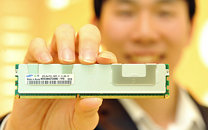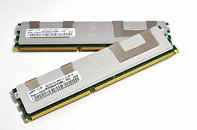Monday, March 29th 2010

Samsung First to Begin Shipping 40nm-class, 32-Gigabyte Memory Module for Servers
Samsung Electronics Co., Ltd., the world leader in advanced memory technology, announced today that it has begun shipping samples of the industry's highest-density memory module for server systems. The 32 gigabyte (GB) module has been designed for use in advanced servers, which require high-density and high-performance features at low-power consumption levels.
According to Soo-In Cho, president and general manager of Samsung Electronics Memory Division, "Samsung continues to set the pace in advanced memory for high-end server applications by offering 40nm-class 32GB memory modules to reach previously unattainable levels of system capacity.In just 10 months, Samsung has now secured the best competitive advantage with the broadest portfolio of 40nm-class DDR3 based memory solutions in the industry since the 40nm-class DRAM was first produced last July.""Technology leadership is a key factor in Samsung's aggressive competitiveness within the memory industry," Mr. Cho emphasized, "Our highly successful implementation of 40nm-class technology is indicative of our determination to move toward the 30nm-class process node in the second half of this year. Our 30nm-class technology will provide even more advanced memory solutions for high-end server and PC applications".
Samsung is using the industries highest-density monolithic DDR3 device - a 40-nanometer (nm) class, four gigabit (Gb) DDR3 chip - as the building block for the new 32GB module. This comes just one year after the company announced its 50nm-class 2Gb based, 16GB registered dual inline memory module (RDIMM) last March.
The highly-efficient 32GB RDIMM consists of 36 dual-die 40nm-class 4Gb DDR3 chips that can perform at equal or greater levels to a 40nm-based 16GB RDIMM with no increase in power consumption. By equipping a dual CPU, two-way server with 32GB modules, a server system can have up to 384GB of memory. This allows for doubling the previously largest density of 192GBs per server with a power increase of less than five percent over that needed for a 16GB module-based system.
In addition, replacing 12 DRAM modules of 16GB density with just six 32GB modules would achieve a 192GB total density, while allowing the DRAM operating speed in a two-way server system to rise by 33 percent from 800 megabit per second (Mbps) to 1,066 Mbps, as power is cut by 40 percent.
In high-performance, four-way servers using 16GB modules, one terabyte of DRAM would be commonplace.By using 32GB RDIMMs, Samsung is moving toward providing four-way servers with 2TB of DRAM each, a migration that it believes will spur introduction of diverse software and a broader scale of server applications.
Mass production of the 32GB RDIMM is slated to begin next month.
According to Soo-In Cho, president and general manager of Samsung Electronics Memory Division, "Samsung continues to set the pace in advanced memory for high-end server applications by offering 40nm-class 32GB memory modules to reach previously unattainable levels of system capacity.In just 10 months, Samsung has now secured the best competitive advantage with the broadest portfolio of 40nm-class DDR3 based memory solutions in the industry since the 40nm-class DRAM was first produced last July.""Technology leadership is a key factor in Samsung's aggressive competitiveness within the memory industry," Mr. Cho emphasized, "Our highly successful implementation of 40nm-class technology is indicative of our determination to move toward the 30nm-class process node in the second half of this year. Our 30nm-class technology will provide even more advanced memory solutions for high-end server and PC applications".
Samsung is using the industries highest-density monolithic DDR3 device - a 40-nanometer (nm) class, four gigabit (Gb) DDR3 chip - as the building block for the new 32GB module. This comes just one year after the company announced its 50nm-class 2Gb based, 16GB registered dual inline memory module (RDIMM) last March.
The highly-efficient 32GB RDIMM consists of 36 dual-die 40nm-class 4Gb DDR3 chips that can perform at equal or greater levels to a 40nm-based 16GB RDIMM with no increase in power consumption. By equipping a dual CPU, two-way server with 32GB modules, a server system can have up to 384GB of memory. This allows for doubling the previously largest density of 192GBs per server with a power increase of less than five percent over that needed for a 16GB module-based system.
In addition, replacing 12 DRAM modules of 16GB density with just six 32GB modules would achieve a 192GB total density, while allowing the DRAM operating speed in a two-way server system to rise by 33 percent from 800 megabit per second (Mbps) to 1,066 Mbps, as power is cut by 40 percent.
In high-performance, four-way servers using 16GB modules, one terabyte of DRAM would be commonplace.By using 32GB RDIMMs, Samsung is moving toward providing four-way servers with 2TB of DRAM each, a migration that it believes will spur introduction of diverse software and a broader scale of server applications.
Mass production of the 32GB RDIMM is slated to begin next month.


13 Comments on Samsung First to Begin Shipping 40nm-class, 32-Gigabyte Memory Module for Servers
That's epic, if only my motherboard could support dimms that capacity...triple-channel 96GB of ram...That's more than my SSD raid array's capacity!
2TB of ram, who would have thunk it? Also, what does one do with 2TB of ram? What server would need that much random access?
it could be as small as under a gig, or bigger than 8 - the majority i would think lie somewhere in between.
Built a pair of servers for VM and other purposes at my last job. Both were Xeon 5520 (single) with 12GB (3 x 4GB). Each ran a number of 2-core 1GB/2GB VM servers, except for Exchange 2007 which likes a little more at 3GB.
Plan was to eventually phase out the older servers and run on only those two, adding a second CPU and 12GB if needed.
With desktop visualization the goal is to fit as many user machine instances on each box. 2P/12-slot board hold 48GB easily/cheaply and two Xeon 55xx could handle the load of 4 dozen VM's easily.
Many companies have various user needs so it's never as easy as "I have x users" though. I just know my users/their usage.
But dang i want 64gb dual channel now!!